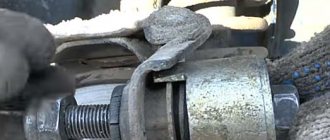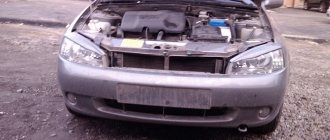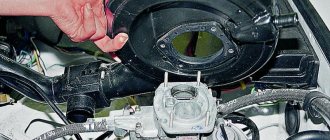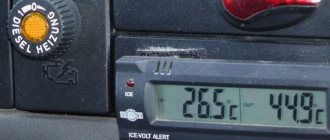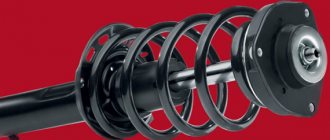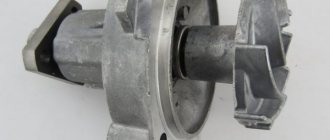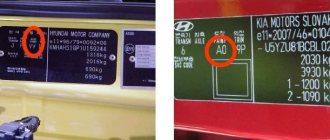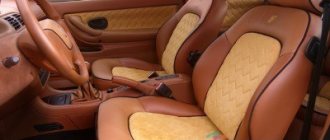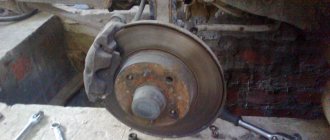How to make a silent block remover with your own hands? It will be no worse than store-bought
Quite a lot of car enthusiasts are interested in how to make a silent block remover with their own hands.
After all, these vibration-reducing suspension elements have to be changed quite often. Moreover, this applies not only to domestic cars, but also to many foreign cars. The problem is related to the poor quality of roads. A sporty driving style also negatively affects the technical condition of silent blocks as part of the suspension. Incorrect installation will not extend the service life. Many mechanics hammer the silent block with a hammer. In this case, the rubber is damaged and the metal bushing may become dislodged. Therefore, always use pullers; as a last resort, there are completely harmless methods to put the part in place without the help of specialized tools. We will talk about this at the end of the article.
How to make a silent block remover with your own hands? Before answering this question, it is advisable to understand what a silent block is. This will make it easier to make a puller.
A silent block is a rubber-metal joint that is capable of dampening vibrations that occur in the suspension. On passenger cars, a part made in the form of a metal bushing with an elastomer body is more common. The most common option for making a hinge is regular rubber. But polypropylene hinges can be called the most durable and high-quality. It is recommended to purchase exactly these when replacing.
Silent blocks VAZ 2107
On the Internet, the specifics of replacing the silent blocks of the suspension of the VAZ 2107 and other cars of the domestic and foreign automobile industry are often discussed. The problem is actually urgent and is due to the poor quality of our roads. Since the silent block is one of the important elements of the vehicle suspension design, special attention must be paid to its selection and replacement.
What are silent blocks
The silent block (hinge) structurally consists of two metal bushings connected to each other by a rubber insert. The part is designed to connect suspension elements, and the presence of rubber allows you to dampen vibrations that are transmitted from one unit to another. The silent block must perceive and endure all deformations to which the car suspension is subjected.
Where are they installed?
On the VAZ "Seven" silent blocks are installed in the front and rear suspension. At the front, levers are attached using this part, and at the rear, reaction rods (longitudinal and transverse) connect the axle to the body. To ensure that the car's suspension is always in good condition and handling does not deteriorate, you need to monitor the condition of the silent blocks and replace them in a timely manner.
What types of silent blocks are there?
In addition to the purpose of silent blocks, you need to know that these products can be made of rubber or polyurethane. It is generally accepted that replacing rubber suspension components with polyurethane ones, where possible, will only improve the characteristics and performance of the suspension.
Silent blocks made of polyurethane are characterized by a longer service life, unlike rubber ones.
The disadvantage of polyurethane elements is their high cost - they are about 5 times more expensive than rubber ones. When installing polyurethane products on a VAZ 2107, you can improve the car's behavior on the road, reduce deformations in the suspension, and also eliminate the so-called squeezing, which is characteristic of rubber elements. This means that the suspension will operate in the condition intended by the designers at the factory. With the correct selection and installation of polyurethane parts, noise and vibration are reduced and shocks are absorbed, which indicates the better performance of such hinges compared to rubber ones.
Making a puller
As already written above, it is not recommended to remove this part from the car without a puller. When removing, you can hit the paw (lever) and damage it. Moreover, the worst thing here is microcracks that can come out at the most inopportune moment. This will lead to an accident. Hammering a new silent block into place damages the mounted part. Soon after the replacement, your car's suspension will begin to knock again.
It is also possible that the wheel alignment angles may be disrupted (this is only possible on models with four-link suspension). In this case, you will not only get an extraordinary replacement of the joints, but also the need to purchase new wheels.
A purchased tool, in this case, is not always the best choice. They are not always reliable. Also, you should buy them, but why spend money on something that you can easily make yourself from practically waste material. Another reason why people try to make such a device on their own is the need to change the hinge, but there is no puller at hand.
First you need to understand how the puller works. In the simplest version, by tightening the nut, the silent block is squeezed out of the lever eye. There are also hydraulic devices. They work on the same principle, but are driven in different ways. It is almost impossible to assemble a hydraulic puller in a garage. Therefore, we will make a screw version of the device.
To work you will need the following:
- Bolt. It is selected empirically;
- Cylinder. It should be slightly wider than the hole in which the silent block is placed;
- Several washers. One should reliably cover the cylinder hole. Sometimes it is simply welded onto one of its ends.
- The rest should be smaller than the diameter of the silent block;
- Suitable size nut.
Assembling the device is quite simple; insert the bolt into the cylinder. On the reverse side it is assumed that a nut will be installed. All that remains is to put this miracle of garage assembly into practice. The puller works like this:
- Remove the silent block axis. For greater convenience, it is better to remove the lever from the machine. But, on some models you can do the work directly on the car. We clamp the removed paw in a vice;
- To press out the hinge, you need to install a cylinder on one side. The bolt is inserted into the hole. Please note that its length should allow you to place several washers on the other side and screw on the nut;
- Place the washers and begin to tighten the nut on the resulting puller. Gradually, it will squeeze the silent block out of the mounting hole.
As you can see, making such a device for removing hinges is not too difficult.
What is a puller for installing silent blocks?
This is what a RMSH puller looks like, which you can make yourself. In order to make it yourself, at home, you will need the following materials and tools:
- Bolt with nut. The diameter and pitch of the thread are at your discretion. If the thread is small, you will have to turn it longer, but it will work easier and smoother.
- We select a cylinder with a diameter such that the silent block fits into it.
- Washers. Some. One washer should tightly cover the cylinder hole. You can even weld the washer on one side. We take the remaining washers with a smaller diameter than the diameter of the silent block.
A RC puller is needed not only for removal, but also for installation, so as not to damage the new silent blocks. And when removing with a puller, there is no need to hit with a hammer and there is no risk of damaging the paws (levers). If you knock out rubber-metal hinges with a hammer, microcracks may appear on the lever.
On cars with 4-link suspension, the wheel alignment angles may be disrupted if the levers or new silent blocks are damaged. In this case, you will have to change the rubber-metal bushings and, possibly, the wheels again.
In terms of cost, pullers for automobile silent blocks can be purchased at prices ranging from 800 rubles to 30,000 rubles (a set of different pullers). But, it is easy to make from improvised means. The principle of operation of a mechanical puller is that when the nut is tightened, the silent block itself is squeezed out of the eye of the lever. Hydraulic ones are more complex in design, they are more powerful, but it is better to buy them when necessary; it is impossible to make them from scrap materials.
Read also: Test of child car seats auto review
How to use the puller
Let us immediately note that replacing silent blocks without a puller is fraught with damage to the mechanism parts. Very smart craftsmen resort to hammering the inside of the device, but this leads to the fact that the uneven fit of the inside can be damaged.
A hydraulic silent block remover allows you to disconnect one part of the device from another without damaging them. Its operation scheme is based on unscrewing or screwing in a special long device with a thread, which will evenly lower or raise the inner part. This process is called pressing and the smoother and more uniform it is, the longer the service life of the device.
When repairing a car, it is important to remember that the suspension must be in its working position before repairing its components. If this rule is ignored, then the installed silent block can significantly reduce the time of its quality work.
Depending on what type of mechanism is on the car (with or without partitions), the type of installation will change. But this is absolutely not important given what kind of puller the puller should be. It can be either purchased or homemade. Its operation scheme in one case or another is the same: one part is attached to the internal unit, and the other to the external one. Using the twisting method, one part is removed from the other.
Before you start making your own silent block, it’s worth considering the drawing of a silent block puller and looking at the ready-made store-bought version. In the markets, such devices have a similar appearance to home ones, since their design is very simple - a few metal parts and bolts of the appropriate size.
How to choose
Of course, before moving on to choosing a specific puller for the front or rear silent blocks, you first need to understand what kind of device it is and what it is used for.
Appearance
There can be a wide variety of such tools, because today they are presented both as a separate C-shaped device with several attachments, and as whole sets, which include guide pins with nuts, sleeves and support disks for them.
There are also universal pullers and those designed for a specific car brand , which must be taken into account when purchasing.
A correctly selected product will help you easily cope with difficult work, since the silent block is quite firmly fixed in its seat and sometimes it takes a lot of effort to remove it.
Depending on the type of part (whether it is an element of the front suspension, stabilizers or fastening of torque rods) installed on a car or truck, a puller for removing silent blocks - elements that reduce rattling and noise when the vehicle is moving - will have its own characteristics.
Among the wide variety of domestic and foreign tools presented on modern markets, you can find absolutely any puller that will meet all the technical parameters of your machine and individual requirements (for example, cost).
However, the main task in any case remains the choice of a quality product that will serve faithfully for many years. Therefore, now we invite you to familiarize yourself with the list of characteristics that are worth paying attention to, and the list of features that are unworthy of it.
What to look for:
So, when choosing a silent block remover for VAZ cars or foreign cars, you should consider the following:
- the model of your car, unless, of course, you decide to buy a universal tool (by the way, there is an opinion that specialized products are much more durable than universal pullers, but in practice it all depends on the manufacturer);
- the presence of smooth edges in all threaded connections of special tools;
- absence of rough areas and open shells;
- ease of unscrewing and tightening detachable parts;
- the requirements of the selected model for other, additional tools, without which it cannot be operated;
- type of puller: manual or hydraulic (for personal use or for car maintenance in small workshops, the first option will be sufficient);
- Availability of instructions in a language you understand.
Sellers can assure you that the same instructions are not so important, because the mechanism of the tool is extremely simple and easy to use, but you must understand that when delivering quality products, such a trifle cannot be a problem.
What you can ignore:
In addition to the indicated important criteria for choosing a silent block remover (both universal and for specific vehicle models), there are also several less significant nuances that can often be regarded as a regular advertising ploy. These include:
- a list of functions that almost all models perform: easy removal of silent blocks, long service life, etc.;
- the relationship between price and quality (despite the fact that many people associate these two indicators, more well-known companies may unreasonably inflate the prices of their tools, and with a more careful study of the offers on the market, you can find a puller with the same characteristics, but at a more affordable price) .
Instructions
The hydraulic silent block puller is universal. It can be used to perform both device removal and pressing. It’s not difficult to make such a mechanism - just a few parts and a couple of hours of time are enough, but you can use it every time you repair suspension parts.
So, the tools that will be needed to produce a puller are: a motorist’s kit with many keys and screwdrivers, a small piece of strong metal pipe with a diameter that is slightly larger than the silent block taken, several large steel washers, a long bolt with high-quality threads, special clothing and construction gloves.
The work progress should be as follows:
- We study the entire structure of the car and in particular its suspension. We look at the new and old part, analyze their structure and try to understand how best to use the puller.
- On one side of the prepared pipe we insert a silent block, which should be replaced according to plan, and on the other side of the pipe we insert a new mechanism. The scheme of work is to squeeze out the old one with a new part (this way neither one nor the other will be damaged).
- We direct the new silent block 100% exactly into the seat, take the prepared bolt and screw it to the center. The initial screwing may be a little heavy, in which case it may be worth tapping the pieces with a hammer a little and continuing with the process. Starting from the middle, this bolt will go in so easily that you can turn it with two fingers. But perform this process only with gloves so as not to damage the limbs.
- If you want to save the old part, then such a puller does not provide for this process and the worn part may simply fall onto the sand. Therefore, you can additionally build a small stand that will perform this function. This could be a simple cup with wire-shaped metal handles or some other device.
Replacing silent blocks in the upper control arm of a classic with your own hands.
So, let's begin! In rear-wheel drive VAZs, the silent blocks in the upper arm can be changed without even driving into a hole and without removing the arm from the ball (provided that you have a remover for silent blocks). But first you need to determine whether the bushings of the silent blocks are stuck to the bolt securing the lever to the body. To do this, jack up the car and remove the wheel.
Arrows point to bolt and nut
We loosen the nut securing the upper arm with a 22mm wrench and try to turn the bolt. If it spins and the bushings stay in place, then you're in luck! But if this bolt rotates with great force and the bushings rotate with them, then as they say: “Houston, we have problems!” Next we will consider both cases.
If the silent blocks are not stuck.
Further actions depend on whether you have a puller for silent blocks. If there is one, then you don’t have to remove the lever completely, but just unscrew the nut 22 to the end, take out the bolt and turn the lever towards yourself (for the convenience of further repairs).
We turn the lever for convenience.
How to use the puller
Let us immediately note that replacing silent blocks without a puller is fraught with damage to the mechanism parts. Very smart craftsmen resort to hammering the inside of the device, but this leads to the fact that the uneven fit of the inside can be damaged.
A hydraulic silent block remover allows you to disconnect one part of the device from another without damaging them. Its operation scheme is based on unscrewing or screwing in a special long device with a thread, which will evenly lower or raise the inner part. This process is called pressing and the smoother and more uniform it is, the longer the service life of the device.
When repairing a car, it is important to remember that the suspension must be in its working position before repairing its components. If this rule is ignored, then the installed silent block can significantly reduce the time of its quality work.
Depending on what type of mechanism is on the car (with or without partitions), the type of installation will change. But this is absolutely not important given what kind of puller the puller should be. It can be either purchased or homemade. Its operation scheme in one case or another is the same: one part is attached to the internal unit, and the other to the external one. Using the twisting method, one part is removed from the other.
Before you start making your own silent block, it’s worth considering the drawing of a silent block puller and looking at the ready-made store-bought version. In the markets, such devices have a similar appearance to home ones, since their design is very simple - a few metal parts and bolts of the appropriate size.
Instructions
The hydraulic silent block puller is universal. It can be used to perform both device removal and pressing. It’s not difficult to make such a mechanism - just a few parts and a couple of hours of time are enough, but you can use it every time you repair suspension parts.
So, the tools that will be needed to produce a puller are: a motorist’s kit with many keys and screwdrivers, a small piece of strong metal pipe with a diameter that is slightly larger than the silent block taken, several large steel washers, a long bolt with high-quality threads, special clothing and construction gloves. The work progress should be as follows:
- We study the entire structure of the car and in particular its suspension. We look at the new and old part, analyze their structure and try to understand how best to use the puller.
- On one side of the prepared pipe we insert a silent block, which should be replaced according to plan, and on the other side of the pipe we insert a new mechanism. The scheme of work is to squeeze out the old one with a new part (this way neither one nor the other will be damaged).
- We direct the new silent block 100% exactly into the seat, take the prepared bolt and screw it to the center. The initial screwing may be a little heavy, in which case it may be worth tapping the pieces with a hammer a little and continuing with the process. Starting from the middle, this bolt will go in so easily that you can turn it with two fingers. But perform this process only with gloves so as not to damage the limbs.
- If you want to save the old part, then such a puller does not provide for this process and the worn part may simply fall onto the sand. Therefore, you can additionally build a small stand that will perform this function. This could be a simple cup with wire-shaped metal handles or some other device.
There are other methods and improvised means that can serve as a removable mechanism. When creating such a device with your own hands, consider what is present in your garage and which of these is least necessary. It is these details that can be used. Analyze and turn on your thinking - something will immediately come to mind.
It is worth understanding that depending on which beam of the car is being repaired, there may be a different silent block, but the instructions for creating a puller described above will be suitable for different types of devices and can be used for both the rear and the front.
When creating a device, it is worth remembering that a certain car model has its own parameters and parts, which may be different in structure and size. It is important to take into account all the features of the car so that the created puller is suitable and can work with this device.
Silent block remover device
The term “ silent block remover ” means a set of parts and tools designed to remove silent blocks from a vehicle. The kits are different, with a minimum/maximum number of accessories. There are also kits that are designed for specific car models and universal ones.
A puller is a necessary tool not only in a car service center, but also in the garage of any car enthusiast. It allows you to remove the silent block without much difficulty, without damaging the remaining parts (when using a hammer, the parts are deformed).
All pullers are divided into specialized and universal. The first type of device is made for a specific brand of car and is not suitable for others (the instructions always indicate which model the unit is intended for). It is believed that a specialized unit is more reliable and durable. The second type is suitable for most models. Its service life and strength depend on the manufacturer.
Silent block pullers have the following design (the simplest model):
- 2 washers that differ in size (one is larger, the second is smaller).
- 1 bolt, long, made of steel.
- 1 nut.
- 1 tube made of steel.
All pullers have the same installation and application principle: correct installation of the device, pressing out the old part, pressing in the new one. The device for pressing silent blocks can be mechanical or hydraulic. The difference is in product size, cost, ease of use and accuracy of work.
What types of silent block removers are there?
The device for removing silent blocks has the following varieties:
- Mechanical. It is considered a universal device. Often implemented in a set. This puller is equipped with internal and external mandrels of various diameters, as well as threaded pins. This kit is used by specialists who need to service cars in car service centers (service stations). Facilitates and speeds up the work process. However, it cannot be used for pressing/pressing large parts.
- Hydraulic puller . Thanks to its design, such a device is capable of servicing cars of different types and brands. The likelihood of damage to other parts and spare parts is reduced. Designed for pressing out and pressing in silent blocks. Consists of a hydraulic cylinder with a piston, a metal stud with thread, a bushing, and cups.
A universal (mechanical) silent block puller differs from a hydraulic one in price, design and method of application. In the first case, screwing the bolt into the puller body (i.e. force) occurs manually, and in the second case, using hydraulics (hydraulic cylinder and hydraulic pump).
- Does not require much physical effort from the master.
- The hydraulic mechanism allows replacement simply and quickly, which is important when providing services.
- Can be used for many brands of cars (trucks and cars).
- When replacing parts, it does not require removing large parts from the machine.
- Allows you to more accurately install the unit with the correct grip depth.
- Increases safety at work.
The package includes a hydraulic pump with working fluid (can be built-in or remote), a hydraulic cylinder, a high-pressure hose, connecting elements, a support and the unit itself. If necessary, you can order additional components (for example, a stud of the required diameter). The silent block pressing tool is a universal and necessary tool at every service station.
How to use the puller
Let us immediately note that replacing silent blocks without a puller is fraught with damage to the mechanism parts. Very smart craftsmen resort to hammering the inside of the device, but this leads to the fact that the uneven fit of the inside can be damaged.
A hydraulic silent block remover allows you to disconnect one part of the device from another without damaging them. Its operation scheme is based on unscrewing or screwing in a special long device with a thread, which will evenly lower or raise the inner part. This process is called pressing and the smoother and more uniform it is, the longer the service life of the device.
When repairing a car, it is important to remember that the suspension must be in its working position before repairing its components. If this rule is ignored, then the installed silent block can significantly reduce the time of its quality work.
Depending on what type of mechanism is on the car (with or without partitions), the type of installation will change. But this is absolutely not important given what kind of puller the puller should be. It can be either purchased or homemade. Its operation scheme in one case or another is the same: one part is attached to the internal unit, and the other to the external one. Using the twisting method, one part is removed from the other.
Before you start making your own silent block, it’s worth considering the drawing of a silent block puller and looking at the ready-made store-bought version. In the markets, such devices have a similar appearance to home ones, since their design is very simple - a few metal parts and bolts of the appropriate size.
Instructions
The hydraulic silent block puller is universal. It can be used to perform both device removal and pressing. It’s not difficult to make such a mechanism - just a few parts and a couple of hours of time are enough, but you can use it every time you repair suspension parts.
So, the tools that will be needed to produce a puller are: a motorist’s kit with many keys and screwdrivers, a small piece of strong metal pipe with a diameter that is slightly larger than the silent block taken, several large steel washers, a long bolt with high-quality threads, special clothing and construction gloves. The work progress should be as follows:
- We study the entire structure of the car and in particular its suspension. We look at the new and old part, analyze their structure and try to understand how best to use the puller.
- On one side of the prepared pipe we insert a silent block, which should be replaced according to plan, and on the other side of the pipe we insert a new mechanism. The scheme of work is to squeeze out the old one with a new part (this way neither one nor the other will be damaged).
- We direct the new silent block 100% exactly into the seat, take the prepared bolt and screw it to the center. The initial screwing may be a little heavy, in which case it may be worth tapping the pieces with a hammer a little and continuing with the process. Starting from the middle, this bolt will go in so easily that you can turn it with two fingers. But perform this process only with gloves so as not to damage the limbs.
- If you want to save the old part, then such a puller does not provide for this process and the worn part may simply fall onto the sand. Therefore, you can additionally build a small stand that will perform this function. This could be a simple cup with wire-shaped metal handles or some other device.
There are other methods and improvised means that can serve as a removable mechanism. When creating such a device with your own hands, consider what is present in your garage and which of these is least necessary. It is these details that can be used. Analyze and turn on your thinking - something will immediately come to mind.
It is worth understanding that depending on which beam of the car is being repaired, there may be a different silent block, but the instructions for creating a puller described above will be suitable for different types of devices and can be used for both the rear and the front.
When creating a device, it is worth remembering that a certain car model has its own parameters and parts, which may be different in structure and size. It is important to take into account all the features of the car so that the created puller is suitable and can work with this device.
At the end of the article, I would like to note that a working silent block helps the car drive smoothly, without unnecessary vibrations. It can remove vibrations that emanate from one part of the machine to another quite well, thereby making movement more comfortable. A caring driver always monitors the condition of the car’s suspension, so adjacent parts are very important to him. It is not so difficult to make a puller for silent blocks with your own hands, so try to make it from scrap materials - this way you will save a lot of money. Good luck in job!
FORCE 949T1
The model belongs to the hydraulic puller type, the set of which includes 49 items. With its help, you can easily disassemble the bushing and replace it (with the exception of parts without holes). Compared to the above puller options, FORCE 949T1 is lighter and easier to use.
Characteristics:
- The maximum load on the cylinder is 18.2 t.
- The comfortable and durable spindle has dimensions: Ø 16 mm, Ø 14 mm, Ø 12 mm, Ø 10 mm.
- Deep mandrels - 22 pieces (18 internal ones of 110 mm each and 26 external ones of 68 mm each).
- Short mandrels - 22 pieces (18 internal 40 mm and 26 external 68 mm).
- Bolts - 4 pieces (diameter 16, 14, 12, 10 mm).
- Type - hydraulic universal puller.
Pros:
- Convenient collars.
- Sturdy case with metal clasps.
- Strong ratchets.
- Long heads.
- The handles are made of high-quality material that is not corroded by technical liquids.
Minuses:
- All parts of the puller are sensitive to moisture and quickly rust when exposed to it.
- High price.
The silent block remover allows you to carefully and without damaging parts (levers) press out worn silent blocks and press in new ones, without even removing the part from the car, motorcycle or scooter. In this article, designed for beginners in chassis repair, the options for pullers, from factory ones to homemade ones, and the principle of operation of the puller will be described and shown.
Silent blocks are found in any car, motorcycle and even moped (scooter), and after a certain mileage of any equipment, the rubber of the silent block ages, wears out, and plays, knocks and defects in the handling of the car appear. Driving becomes uncomfortable and even dangerous and, of course, worn parts require replacement.
Of course, you can replace worn silent blocks with a hammer or sledgehammer, but it is unlikely that impact technology will allow repairs to be made without damaging parts (levers) and hands. You can, of course, use a press for pressing, but firstly, not everyone has one in the workshop, secondly, for the press you will still have to select or sharpen mandrels (bushings), and thirdly, the press will allow you to press out worn silent blocks only from a lever removed from the machine.
Well, a silent block remover, even a homemade one, will allow you to replace worn silent blocks easily, silently and without damaging the parts, and in some cases, pressing out will be done on site, that is, without removing the lever itself from the machine. As a result, the puller allows you to save a lot of nerves and time, and of course you don’t have to swing a hammer.
Nowadays there are plenty of factory pullers on sale for pressing out silent blocks, which are designed according to the diameter of the bushings for specific car models. But on sale you can also find more universal pullers, for example, as in the photo below, which in their set have many pressure bushings of different diameters.
It makes sense to search for and buy this set if you often change cars, that is, you repair them yourself and then sell them, or you repair cars professionally.
If you have one car that you drive for several years and all these years you have been servicing its chassis yourself, then it is best to purchase or make a silent block puller with a bushing diameter only for your car or motorcycle (scooter).
In addition, on most production cars the diameter of the silent blocks is almost the same and often the same puller is suitable for parts of several different brands of cars. But before you go to the store for a puller (or to a turner), you should crawl under your car with a caliper and measure the outer diameter of the worn rubber bushings (silent blocks), which you have to press out and replace with new ones.
This will allow you to buy a puller with bushings specifically for your parts (silent blocks). Of course, many sellers know what model of car the pullers they sell are suitable for, but I’ve met some who didn’t know (especially for motorcycles and scooters), and even if they do know, it’s still better to trust the measuring tool than the seller. An extra check will never hurt and will save you from running back to the store to replace it with another one.
In order for beginners not to make a mistake in the diameter of the pressure bushings of the puller you are purchasing or making, just look at the drawing below, and, as mentioned above, measure the silent blocks on your machine. Of course, all the dimensions in the drawing are purely conditional and we select these dimensions specifically for the silent blocks of your car, and I will write how to choose below.
The drawing shows that the bushing that will put pressure on the silent block when pressing out (the bushing indicated by the red arrow) should be slightly smaller in diameter (about half a millimeter) than the outer metal holder of the silent block (indicated by the green arrow) and, accordingly, slightly smaller than the inner diameter of the mounting hole in the suspension arm of your car.
Well, the large bushing, indicated by the blue arrow in the drawing, should be a few mm larger than the small bushing and the silent block itself (its outer race), but the outer diameter of the large bushing should be no larger than the diameter of the lever itself, ideally the large bushing should rest against the middle of the lever around its hole (the ideal place for the large bushing to stop is indicated by the dotted line in the drawing).
This will allow the bushing (indicated by the red arrow), when pressing out the silent block, to freely pass through the mounting hole in the suspension arm and completely push the worn silent block out. I hope everything is clear to beginners.
Replacing the silent block using a puller. I already wrote about replacing silent blocks using a puller in this article, using the Volga car as an example. But for cars of other brands, the operating principle is almost the same. The main thing, as I said above, is to accurately select the diameter of the puller bushing.
The small bushing of the puller, as can be seen in the drawing, rests against the metal holder of the silent block, and the large bushing rests on the other side against the lever body. Next, we place washers on the bushings (on some puller designs, the washers and bushings are one piece and this is more convenient) and tighten this “sandwich” using a long pin or bolt.
Of course, the pin or bolt should be slightly smaller in diameter than the inner race of the silent block and freely pass through the entire “sandwich”. Next, all that remains is to compress the assembled structure with the help of nuts, and then you need to press with the nuts, pulling together the entire “sandwich”, until the smaller puller bushing squeezes the silent block out of the mounting hole of the lever (in this case, the silent block will be squeezed into the inside of the large puller bushing).
When pressing in a new silent block, we assemble the entire structure in exactly the same way as for pressing out (almost as in the drawing), only the new silent block will not yet be located in the lever, but between the small bushing and the mounting hole in the lever, and the nuts on the stud will be unscrewed a little more accordingly (approximately the width of the silent block).
Again, all that remains is to tighten the nuts, while making sure that at the beginning of pressing the silent block is not distorted, that is, that it is located at the beginning of the lever hole exactly without distortions. We compress the nuts until the new silent block fits completely into the mounting hole of the lever.
Homemade silent block remover.
A homemade puller is not at all difficult to make (again, according to the drawing above) if you have a lathe or a familiar turner. I advise you to sharpen the bushings and washers as one whole, so it will be simpler and easier when installing a puller for pressing out.
Of course, you should sharpen the bushings (as well as the stud) from high-quality carbon steel (for example, ST45, 40X13 and the like). A puller made from such steel will last much longer than any factory Chinese puller that litters markets and stores.
However, if you don’t have a lathe, or a turner you know, then it’s quite possible to make a silent block puller yourself, having only an angle grinder and a drill with a set of drills. You will need to look in the garage trash for sections of pipes of a suitable diameter (even water pipes will do), then cut off the required sections of pipe with a grinder, and then find or make washers from sheet metal that will be slightly larger than the diameter of the pipe sections (bushings).
As bushings you can use not only pipes of a suitable diameter, but also water couplings (see photo), coupling heads from the tool kit. And in general, any cylindrical part lying around in the garage and suitable in diameter can be used in business.
By the way, an example of pressing out silent blocks using a puller made from scrap materials found in garage trash is shown in the video below this article.
The main thing is that the diameters of the found segments match your silent blocks that need to be replaced. I described above how to determine the required diameters.
Well, all that remains is to find or buy a long pin or bolt on the construction market, and a homemade silent block remover from scrap materials is ready, good luck to everyone.
Communities › Do It Yourself › Blog › Do-it-yourself puller-mandrel for replacing VAZ-2107 silent blocks
Video “How to replace a silent block”
The video shows how to replace the silent blocks of the lower control arms of a classic VAZ car using a universal puller.
Professional kits include several washers and bushings of various diameters, including cone-shaped ones; some of them can be used to press out silent parts without removing suspension components.
If human effort is not enough, hydraulics and a press with supports come to the rescue, with which you can change even the most powerful silent block.
This most often applies to truck parts. If there is no time or effort to make a puller, you can resort to other methods of pressing out and replacing silent blocks.
Photo tips on how to replace silent blocks
Replacing front shock absorbers with your own hands: how to quickly and easily remove, check and install shock absorbers on a car (145 photos + video)
Nissan suspension - review of advantages, disadvantages, tips on how to identify the original and ideas for tuning suspension for Nissan (130 photos)
Do-it-yourself suspension repair: how to find the cause of the problem yourself and repair the suspension (120 photos)
Read here! Replacing the power steering pump - how to properly remove and replace the power steering on various brands of cars with your own hands (95 photos)
